Breathtaking images taken by aerial photographer Jason Hawkes show Britain in a wonderful new way.
Whether they’re of man-made structures or natural landmarks, photos taken from above offer a soaring perspective that we would never normally see. BRITAIN talks to the photographer of the book Britain from Above Month by Month about these beautiful images and the spectacular locations.
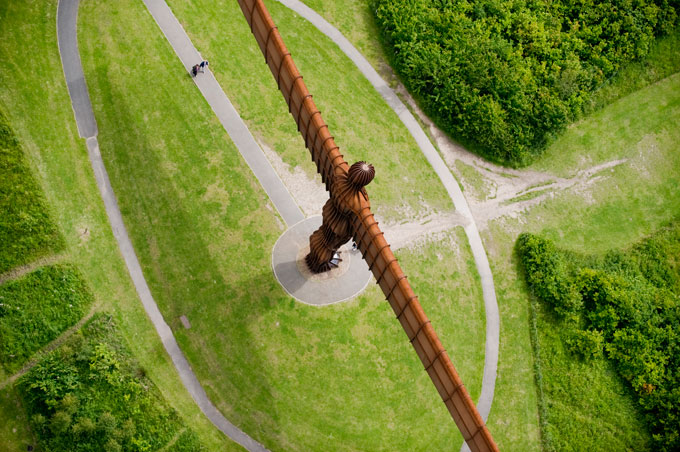
ANGEL OF THE NORTH, GATESHEAD, TYNE & WEAR
Standing an impressive 20-metres (66-feet) high, Antony Gormley’s The Angel of the North is visible for miles in all directions in north-east England. But seeing it from above offers a perfect view of one of its lovingly crafted features – the vast wings tilting slightly forwards at an angle of 35 degrees. This is to create a sense of embrace as the sculpture stretches out a warm welcome to all who see it.
The Angel of the North celebrated its 14th birthday in 2012 and it’s worth recalling that while it was being constructed, it was considered a fairly controversial project. Since it was unveiled, however, it was quickly taken into the hearts of local people and now stands as one of the most popular pieces of public art in Britain.
Many make the trip to see it up close. However, despite it’s scale, Jason says that it seemed, “Tiny from above. In fact, even though you know exactly where it is, it’s quite difficult to find. We had to drop down very low; I guess we are around 500 feet here, and shoot with a 200mm lens in order to get this good, strong crop.” It’s surprising to think that the Angel could ever appear tiny, however its wingspan, at 54 metres (177 feet) is similar to that of a jumbo jet, which look small when we have the reverse perspective, gazing up at planes from the ground.
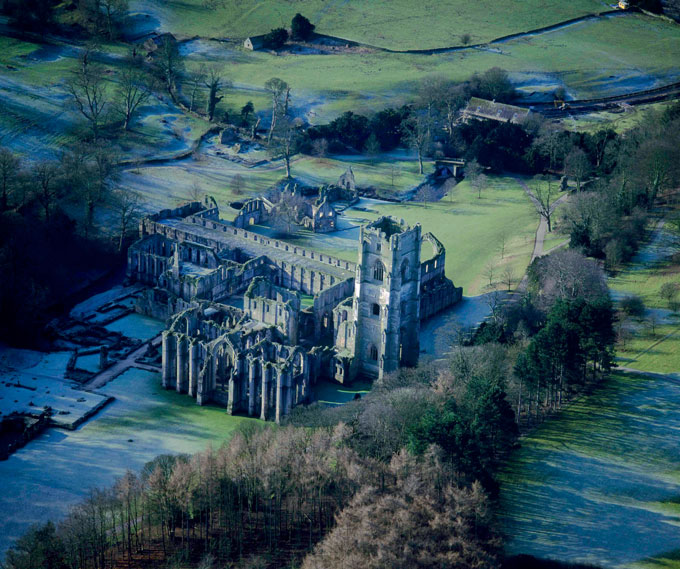
FOUNTAINS ABBEY, RIPON, NORTH YORKSHIRE
The ethereal beauty of Yorkshire’s landscape radiates from this photograph of Fountains Abbey. You could imagine Heathcliff wandering through this tranquil but haunting scene. The great, old Abbey looks as brittle as an intricately crafted model, while the surrounding trees, also robbed of their size, appear to replicate the rounded shrubs of heather that cover much of Yorkshire’s moorland.
Fountains Abbey was built some 700 years before Emily Brontë’s famous novel was published. It was founded in 1132 and operated as an abbey for over 400 years, until the Dissolution of the Monasteries under the orders of Henry VIII. Not all of the Abbey’s architecture dates this far back. The tower, which stands highest in this image at 49 metres (160 feet), was added just before the Dissolution in the early 16th century. Nonetheless, its state of preservation is so remarkable that it was awarded UNESCO World Heritage Site status in 1986. Jason acknowledges the challenges of capturing the Abbey at breaking light: “I’m not often flying at this time of the morning, as dawn landscapes tend to be much hazier than the views you get at dusk, but on this occasion the air was crystal clear.”
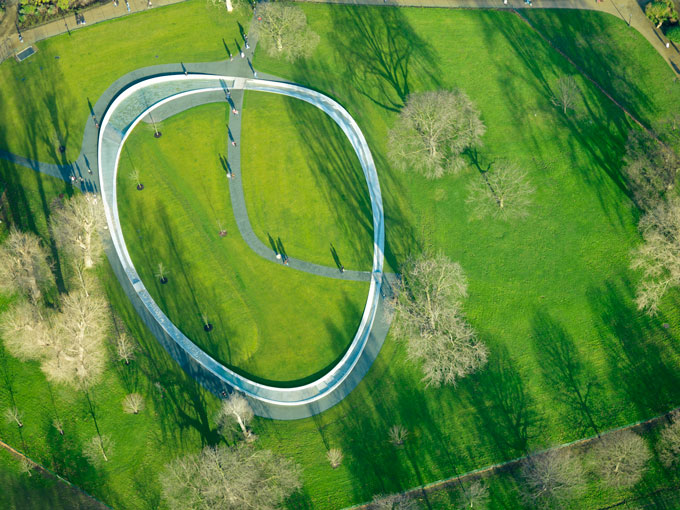
THE DIANA MEMORIAL, HYDE PARK, LONDON
A contradiction of London is that while it’s one of the world’s most populous and modern cities, it’s also an area of rich green expanses. It’s home to eight Royal Parks and this photo captures the quiet peace of the Diana, Princess of Wales Memorial, a small part of the 350 acres that make up Hyde Park.
The memorial fountain was opened in 2004, seven years after Diana’s death. It’s made up of 545 pieces of Cornish De Lank granite, chosen because it would reflect the sparkle of the water, as you can just make out where the sunlight catches it at the memorial’s widest point. It’s actually two separate streams of water, which flow and bubble in either direction from the fountain’s highest point, before meeting in a calm pool at the bottom.
As a reminder of the Princess’s openness, three bridges are in place so visitors can walk through the very middle of the memorial and be surrounded by it. Visitors to Hyde Park on the crisp, clear day this photograph was taken are both walking through it and standing by its edge, their long shadows giving us a more revealing glimpse of them than the overhead view provides.
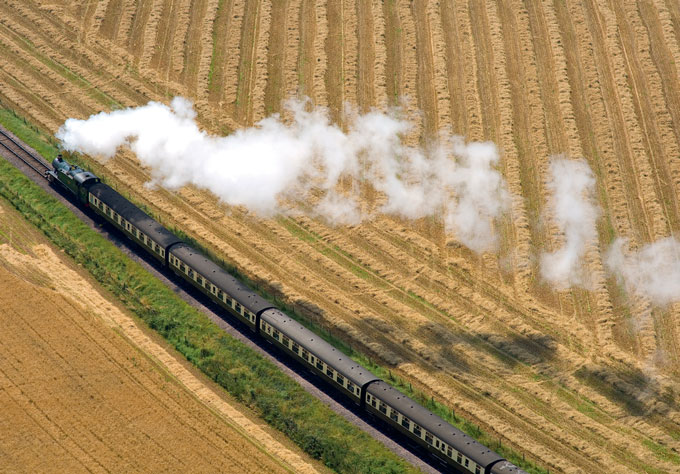
WEST SOMERSET RAILWAY, MINEHEAD, SOMERSET
“When you fly around the country, you constantly come across unusual sights – this one struck me from afar,” Jason told us about this picture, which seems to capture a bygone era. It is more akin to a painting of a steam train by Monet or Turner than a photograph taken in modern Britain.
The West Somerset Railway closed in 1971 but reopened five years later as a heritage line. Now, passengers can enjoy the rolling pleasure of steam travel as they are taken on a journey along the Quantock Hills to the Bristol Channel coast.
Although the steam train is in full motion, there is a magical stillness and serenity to it. The train’s chimney and windows are clear and unblurred, while the clouds of steam billowing into the air have the look of white candyfloss, their shadows reflecting onto the neat rows of wheat in the field.
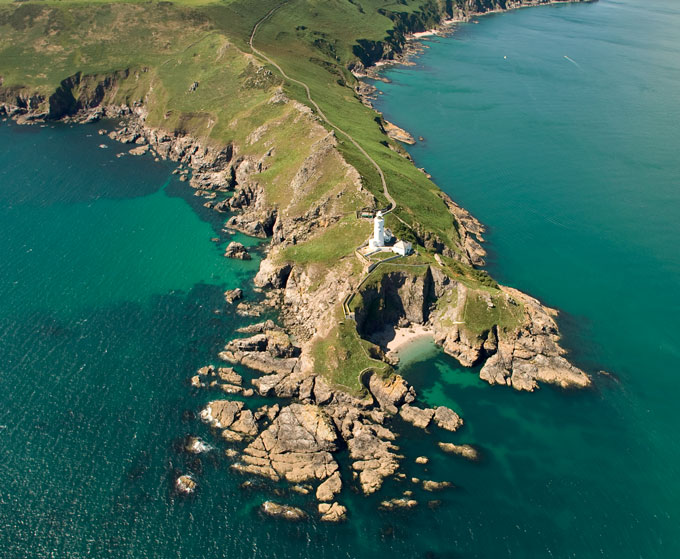
START POINT, DEVON
We end at Start Point, although the name stands not for the beginning but for ‘steort’ the Anglo-Saxon word for tail. Appropriate, because from this dizzying angle, the peninsula looks like a prehistoric creature with a sharp, spiny tail that jets out far into the English Channel. Surrounding it, the clear, turquoise coloured sea looks startlingly different from the darker tones we expect to surround Britain. Also, beside the shadows of the steep cliffs, you can just make out the glint of golden sand on the cove that’s bitten into the rock face.
It’s easy to pay little attention to the architectural feature that’s the only manmade creation for miles around. While the peninsula is spectacular, it was once deadly; the rocks resulting in many shipwrecks in the 19th century. As a result, the Start Point Lighthouse was built in 1836. Look closely at the image and you can make out its Gothic structure and battlemented parapet. From this distance though, the 28-metre (92-foot) tower looks more like a chess piece than a resplendent beacon that’s kept the Channel waters safe for over 150 years.
| To enjoy more than 100 beautiful aerial photographs and for an extraordinary new way to see the country, order your copy of Britain From Above Month by Month, by Jason Hawkes |





 © 2024
© 2024